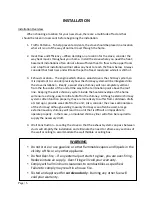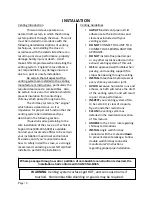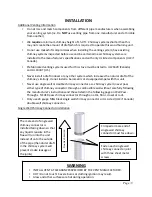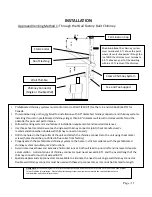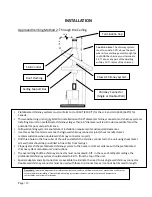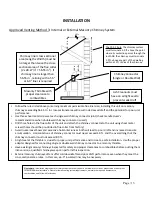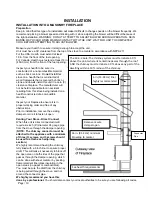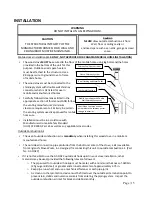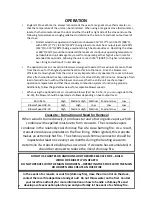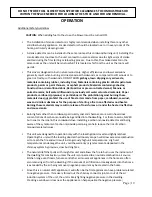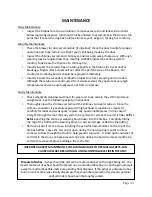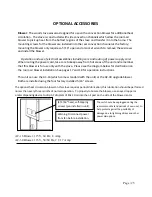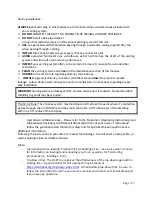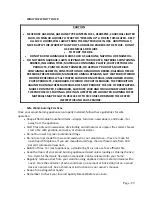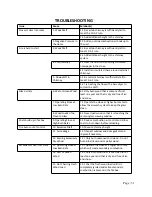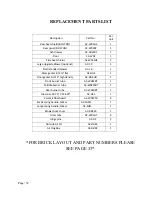
Page | 17
OPERATION
Break
‐
In
Fires
•
This
wood
burning
unit
is
constructed
of
heavy
gauge
steel
and
cast
iron
and
is
built
to
last
a
long
time.
However,
in
order
to
ensure
no
excessive
thermal
stresses
are
induced
on
the
metal
during
the
first
fire,
three
break
‐
in
fires
should
be
burned,
each
one
slightly
hotter
than
the
last.
These
break
‐
in
fires
will
not
only
help
the
stove
body
acclimate
to
the
high
temperatures
of
the
fire,
but
will
also
slowly
cure
the
high
temperature
stove
paint,
which
will
ensure
the
high
quality
finish
lasts
for
years.
WE
HIGHLY
RECOMMEND
burning
your
break
‐
in
fires
outdoors,
as
the
paint
and
manufacturing
oils
will
‘burn
off’
the
stove
exterior
somewhat
during
this
time.
If
you
do
burn
them
indoors
with
your
flue
system,
open
doors
and
windows
to
ventilate.
•
This
stove
has
a
single
air
control
rod
which
regulates
the
wood
burn
rate;
when
the
primary
air
control
slide
is
pushed
all
the
way
into
the
unit,
the
stove
will
burn
more
slowly
and
put
out
heat
over
a
longer
time
period.
Conversely,
when
the
air
control
slide
is
pulled
all
the
way
out,
the
unit
will
burn
more
quickly
and
put
out
a
larger
amount
of
heat
over
a
relatively
shorter
time
period.
Do
not
attempt
to
modify
the
range
of
air
control
adjustment
for
any
reason.
•
The
first
break
‐
in
fire
should
be
just
a
large
kindling
fire,
getting
the
stove
to
about
300
°
F
as
measured
by
a
magnetic
thermometer
on
the
right
or
left
side
of
the
stove,
above
the
door.
Once
this
temperature
has
been
reached,
allow
the
fire
to
die
out
with
the
air
control
open.
The
second
and
third
break
‐
in
fires
should
be
a
bit
larger,
with
some
small
dry
splits
added
to
the
kindling
load.
The
temperature
goal
during
these
fires
is
about
350
°
F
–
450
°
F;
don’t
let
the
fire
get
hotter
than
that.
Continuous
Operation
–
Daily
Operation
after
your
Break
‐
In
Fires
Start
‐
up
-
Load
the
firebox
with
wood,
split
to
moderate
size.
-
On
top
of
the
startup
wood,
add
dry
kindling
split
into
very
small
pieces.
-
Ignite
the
kindling
from
the
top
until
a
flame
is
established.
-
Close
the
door
and
set
the
damper
to
High
(fully
open)
to
reduce
the
amount
of
smoke.
High
Burn
-
Be
sure
the
dog
box
is
not
covered
with
ashes
or
coals
(see
Brick
Layout,
page
33,
for
dog
box
location).
-
Load
wood
load
onto
the
coal
bed
after
chopping
and
packing
coals,
if
necessary.
-
Close
the
door,
set
the
damper
to
High
(fully
open)
and
set
blower
to
High
speed.
Low
Burn
-
Be
sure
the
dog
box
is
not
covered
with
ashes
or
coals
(see
Brick
Layout,
page
33,
for
dog
box
location).
-
Load
wood
load
onto
the
coal
bed
after
chopping
and
packing
coals,
if
necessary.
-
Close
the
door,
set
the
damper
to
High
and
set
blower
to
High
speed.
-
After
15
minutes,
set
the
damper
to
Low
(fully
closed)
and
set
blower
to
Low
speed.
Medium
Burn
-
Be
sure
the
dog
box
is
not
covered
with
ashes
or
coals
(see
Brick
Layout,
page
33,
for
dog
box
location).
-
Load
wood
load
onto
the
coal
bed
after
chopping
and
packing
coals,
if
necessary.
-
Close
the
door,
set
the
damper
to
½
closed
and
set
blower
to
High
speed.
-
After
15
minutes,
set
the
blower
to
Low
speed.




